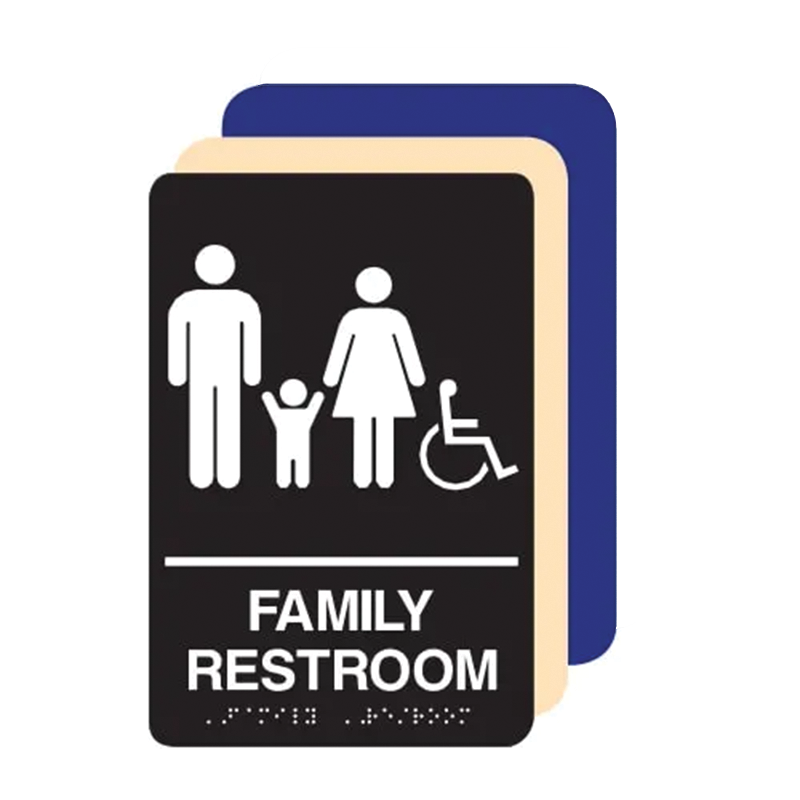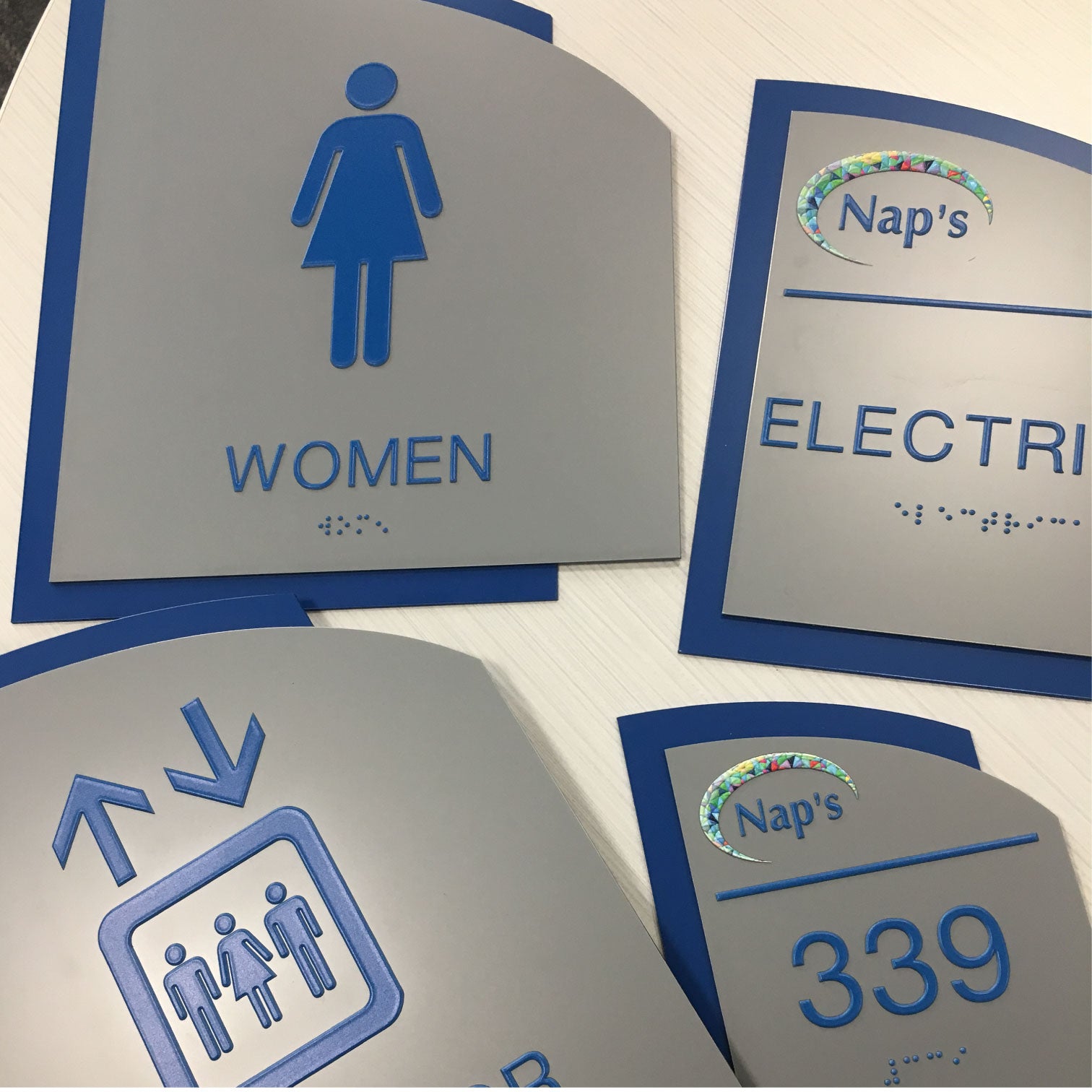ADA Signs: Important Tools for Inclusive Environments
ADA Signs: Important Tools for Inclusive Environments
Blog Article
ADA Signage: Making Sure Access and Conformity in Public Spaces
ADA signage plays a vital function in guaranteeing ease of access and conformity within public areas, considerably adding to an inclusive setting for individuals with impairments. As we explore the nuances of ADA signage, from tactile features to design ins and outs, it's important to think about exactly how these aspects coalesce to promote the civil liberties of all customers.
Value of ADA Signage
In contemporary society, the significance of ADA signage extends beyond simple conformity with legal mandates to symbolize a dedication to inclusivity and access for all people. These signs are important in producing environments where individuals with handicaps can navigate public rooms with the exact same ease and independence as those without disabilities. By offering standardized and clear information, ADA signs ensures that everybody can access facilities, solutions, and details without barriers.
The relevance of ADA signs depends on its capacity to enhance the top quality of life for individuals with specials needs by promoting equal access. It eliminates the obstacles that may otherwise hinder their capability to participate totally in area life. Furthermore, these indications work as noticeable signs of an organization's devotion to variety and equality, showing wider societal values that promote the civil liberties and self-respect of all individuals.
Furthermore, ADA signs plays an important duty in public safety and security. By assisting individuals to departures, restrooms, and other important centers, it makes certain that all people, despite physical capacity, can leave safely during emergency situations. In recap, ADA signs is not simply a regulatory need yet an effective tool for fostering a comprehensive and fair society.
Crucial Element of Compliance

Positioning is crucial; indications have to be mounted in places that are reachable and conveniently noticeable. Commonly, signs needs to be mounted between 48 and 60 inches from the ground to ensure availability for both standing and wheelchair customers. Tactile components, such as Braille, are crucial for people with visual impairments, providing essential info in a non-visual layout.
High-contrast shades in between the message and background are necessary to boost readability for people with low vision. The ADA mandates specific contrast ratios to make sure clearness. Additionally, personality size is an essential factor to consider, with minimum elevation needs determined by the viewing range to ensure readability from various angles.
Layout Considerations for Access
Creating easily accessible signs needs a thorough strategy to ensure it satisfies the requirements of all users, specifically those with disabilities. The dimension of the message is equally critical, with ADA guidelines recommending a minimal elevation based on checking out range to make sure readability.
Contrasting colors in between message and history are necessary for visibility, especially for people with visual problems. A high comparison proportion helps distinguish the message from its history, enhancing readability under various illumination conditions. Furthermore, responsive aspects, such as Braille and elevated personalities, are essential for people that are blind or have reduced vision. These components should be located at a consistent height and position to guarantee easy gain access to and comprehension.
Moreover, the placement of signage plays a considerable duty in access. Indicators should be mounted in areas that are unblocked and quickly reachable. Ensuring that signage is mounted at appropriate elevations and angles allows all individuals, including those using wheelchairs, to interact with them efficiently.
Typical Mistakes to Stay Clear Of

An additional common mistake is the wrong placement of signs. ADA standards specify accurate elevation and place demands to make sure that indicators are obtainable and conveniently visible by all individuals, including those using wheelchairs. Disregarding these guidelines not just hampers availability but likewise runs the risk of non-compliance with lawful standards.
In addition, not enough contrast in between message and history is a frequent oversight. Adequate contrast is crucial for readability, particularly for people with reduced vision. Designers in some cases choose colors that are aesthetically enticing but do not have the necessary contrast, making the message tough to recognize.
Last but not least, some designers fail to include responsive aspects, such as Braille, which are important for individuals who are blind. Omitting these functions not only results in non-compliance with ADA regulations but also restricts accessibility for a segment of the click for info populace that counts on responsive info.
Future Trends in Signs
Developments in innovation and increasing awareness of inclusivity are shaping the future patterns in signs layout. Digital signs, for instance, is progressing to consist of real-time updates and interactive features, which can be vital in read the article providing vibrant details in public spaces.
An additional emerging trend is the usage of enhanced fact (AR) to boost customer experience. AR-enabled signage can overlay digital details onto the physical setting, providing aesthetically damaged people with auditory or haptic feedback. ADA Signs. This modern technology not only enhances accessibility yet additionally develops an engaging experience for all customers
Sustainability is likewise a significant variable affecting signs fads. Environmentally friendly materials and energy-efficient illumination remedies are being prioritized to line up with worldwide environmental goals. Moreover, improvements in materials scientific research are leading to the advancement of even more weather-resistant and long lasting signs.
Conclusion
ADA signage plays an essential function in ensuring availability and about his compliance within public rooms by including tactile aspects, high-contrast shades, and calculated placement. The adherence to ADA requirements not just facilitates safe navigating for people with specials needs however likewise indicates an organization's dedication to variety and inclusivity. By preventing common blunders and embracing future trends, public areas can remain to progress these values, ensuring that the civil liberties and dignity of all people are valued and upheld.
ADA signs plays an important role in assuring ease of access and conformity within public areas, significantly adding to a comprehensive atmosphere for people with specials needs. As we explore the subtleties of ADA signage, from responsive attributes to create ins and outs, it's vital to think about how these elements integrate to maintain the legal rights of all users.In modern-day society, the importance of ADA signage expands beyond mere conformity with lawful mandates to personify a dedication to inclusivity and ease of access for all individuals. By providing clear and standard information, ADA signs makes certain that everybody can access facilities, solutions, and information without barriers.
ADA signs plays an important function in assuring accessibility and compliance within public areas by integrating tactile elements, high-contrast shades, and calculated placement. (ADA Signs)
Report this page